

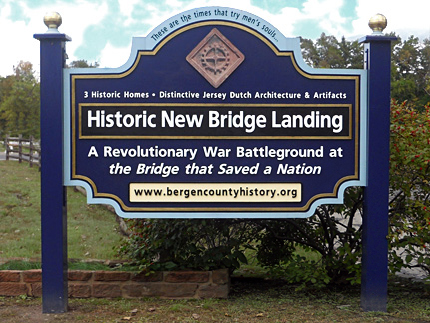
Entrance to Historic New Bridge Landing
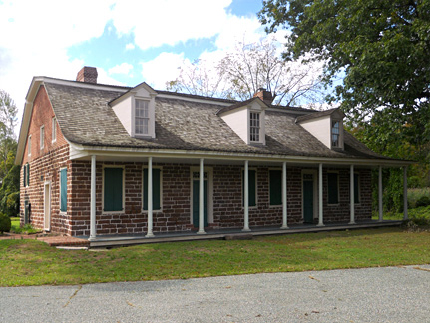
The Zabriskie-Steuben House
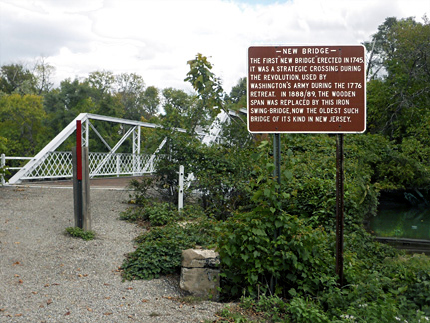

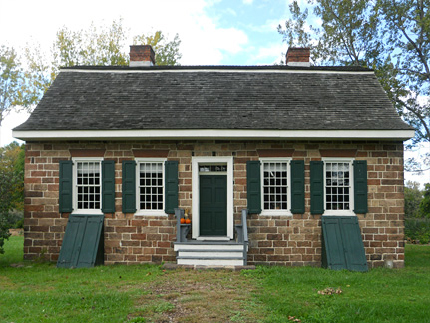
Campbell-Christie House
Built circa 1774
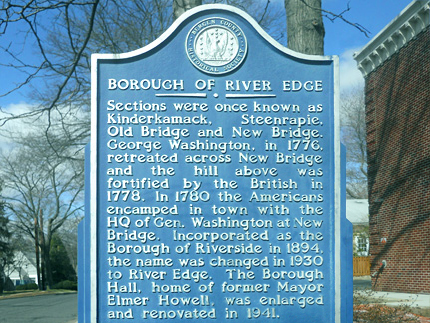
Historic sign located
1.5 miles north of Historic New Bridge Landing,
next to the River Edge Municipal Building
Historic New Bridge Landing
1201 Main St.
Map / Directions to Historic New Bridge Landing
Open for self-guided walking tours.
Individual buildings are open for special events.
For more information, see the Bergen County Historical Society Website
New Bridge Landing
At the beginning of the Revolutionary War, New Bridge Landing was the home of Jan Zabriskie, a merchant who operated a mill on the property. It took its name from a wooden bridge known as the "New Bridge" which spanned the Hackensack River here. Many military incidents occurred at New Bridge throughout the war, making it one of the most significant Revolutionary War sites in New Jersey.
In order to appreciate the importance of bridge locations during the Revolutionary War, it is helpful to remember how different their system of roads and bridges was to our own. North Jersey is now filled with so many roads and bridges that we can generally find a somewhat direct route to wherever we are going. So many paved road bridges pass over the rivers and streams, that we drive over them without giving much thought to the fact that they are bridges. But in the late 1700's, there were much fewer bridges, and so they were spaced out much farther, offering many fewer places to cross a given river.
Such facts had military implications. When armies moved across the state of New Jersey during the Revolutionary War, their movements were often determined by the placement of bridges. This was certainly the case with the New Bridge in November 1776, as General George Washington and the Continental (American) Army made a retreat across New Jersey in one of their darkest moments of the war.
New Bridge - November 1776
"The Bridge that Saved A Nation"
The year 1776 was a tumultuous one for the American cause in the Revolutionary War. July 4th had seen the milestone of the Continental Congress adopting the Declaration of Independence. However, on the military side, the war had gone poorly for General George Washington and the Continental Army. They suffered a series of defeats on Long Island and Manhattan between August and September. Then on November 19-20, British troops invaded New Jersey by crossing the Hudson River from New York and landing at Lower Closter Landing in Bergen County. This forced the Continental Army to evacuate their camp at nearby Fort Lee on November 20, and begin a twelve-day retreat across New Jersey, with the British forces in pursuit behind them. [1]
In order for the Continental Army to make their retreat, they first had to reach and cross the Hackensack River at New Bridge, which they did late on November 20. The main body of troops moved on to Hackensack where they remained for the night, but the rear guard remained at New Bridge, on both sides of the river. The following morning, they were attacked by British troops who were under orders to "secure the New Bridge on the Hackensack River from being destroyed by the enemy in their precipitate retreat." [2] The American rear guard put up a strong fight, but they suffered many casualties and were forced to retreat. [3]
Washington and the Continental Army proceeded from Hackensack to the bridge over the Passaic River into what is now the city of Passaic, They then marched along the west side of the Passaic River to Second River (now Belleville) and Newark, and next headed southwest toward Trenton. They were pursued along the way by British forces. The Continental Army arrived on December 2 in Trenton, where they spent five days moving all the troops and supplies across the Delaware River into Pennsylvania. More bad news followed when the Continental Army's second ranked General, Charles Lee, was captured by the British in Basking Ridge on the night of December 12-13. [4]
This was a desperate time for General Washington, the army, and the country. Thomas Paine famously described this period as "These are the times that try men's souls" in his pamphlet The American Crisis, which was published that December. Paine had been with the army throughout their retreat across New Jersey, and in The American Crisis he specifically mentions the role of the New Bridge. [5]
However, within weeks Washington and his army would turn the tide. On Christmas night, Washington's forces crossed the Delaware River back into New Jersey to win a small but important victory the next morning at Trenton, followed a week later by another victory at Princeton. [6]
These victories had revived their chances and their morale, but none of it would have been possible if they had not reached the New Bridge in time to save the army back on November 20. George Washington described the importance of the escape over the New Bridge in a letter he wrote to New Jersey Governor William Livingston: [7]
(Note that Washington refers to the Hudson River as the North River, and to the New Bridge as Hackinsack Bridge.)
"After the unfortunate Loss of Fort Washington it was determined to evacuate Fort Lee in a great Measure, as it was in a Manner useless in obstructing the Passage of the North River without the Assistance of Fort Washington. The Ammunition and some other Stores were accordingly removed but before we could effect our purpose the Enemy landed Yesterday Morning in very considerable Numbers about 6 Miles above the Fort. Their Intent evidently was to form a line across from the place of their landing to Hackinsack Bridge and thereby hem in the whole Garrison between the North and Hackinsack Rivers. However we were lucky enough to gain the Bridge before them, by which Means we saved all our Men, but were obliged to leave some hundred Barrels of Flour, most of our Cannon and a considerable parcel of Tents & Baggage." (Emphasis added)
New Bridge during the rest of the Revolutionary War
New Bridge remained an important location throughout the rest of the war. While nothing as momentous as the November 1776 crossing occurred again, it was the site of other notable militarily incidents, several of which are described below:
May 18, 1779 - As part of a military incursion by British troops into Bergen County, a skirmish occurred at New Bridge. A British officer described it as, "When we appeared before New Bridge a party of about forty rebels attempted to take up the planks of the bridge, which they could not effect. Several shots were exchanged without damage I believe on either side." [8]
August 18 and 19, 1779 - About 400 American Troops under the command of Henry "Light-Horse Harry" Lee set out from New Bridge to launch a successful attack on the British fort at Paulus Hook, and returned to New Bridge afterwards.
(This story is told in much more detail on the Jersey City page.)May 30, 1780 - 300 British troops attempted to raid this area, but mistakenly attacked each other. A contemporary newspaper included the following report:
"This morning a detachment of about 300 of the enemy, under the command of Col. B[u]skirk, made a descent into this county. Their objective was professedly to murder and carry off the militia. They divided themselves into two parties, each going upon a scout. They met at the house of J. Zabriskie at about one o'clock, A.M. and mistaking each other for the rebel guard, (as they call it) fell upon each other in a most furious manner, and by the discharge of their muskets and use of the bayonet, they appear to have made a dreadful slaughter; the ground 'round the house being in a measure covered with blood, and in some places the clotted gore remained in heaps when I arrived at the spot, which was at five o'clock.—After this, they finding their mistake, retreated over and took up the bridge to prevent our men pursuing them. 'Tis said they had seven or eight killed on the spot, besides wounded.--- All were carried off." [9]July 20-21, 1780 - 2000 American troops under General "Mad Anthony" Wayne assembled at New Bridge at 9 PM on July 20.
At 1 AM, they began a ten-mile march to attack a British blockhouse at Bull's Ferry (modern-day North Bergen).
Meanwhile, Wayne left a small force of one hundred men and one cannon to guard the New Bridge.
The attack on the blockhouse at Bull's Ferry was unsuccessful, and the troops returned to New Bridge on July 21. [10]September 4-20, 1780 - Washington made his headquarters at New Bridge, while about 14,000 American troops encamped along nearby Kinderkamack ridge. [11]
After the Revolutionary War, the Zabriskie House is given to General Von Steuben
The home of Jan Zabriskie at New Bridge was confiscated by the State of New Jersey in 1781 because Zabriskie was a Loyalist. On December 23, 1783, several months after the official end of the Revolutionary War, the state gave the house to Major-General Baron von Steuben in recognition of his service during the war. [12] Steuben ended up selling the house back to the Zabriskie family in 1788. [13]
Steuben was a Prussian military officer who came to America in 1777 to fight on the American side in the Revolutionary War. In early 1778, von Steuben went to the Continental Army's winter encampment at Valley Forge, PA, where he instituted a system of training which contributed greatly to the improvement of the army. He served as Inspector-General of the Continental Army. A statue honoring Steuben is located at the Monmouth Battlefield State Park in Manalapan.
Visiting Historic New Bridge Landing
Historic New Bridge Landing is now a state historic site. In addition to the Steuben House which still stands here at its original location, several other historic buildings have been moved here. One of these buildings, the Campbell-Christie House, was built circa 1774 by Jacob Campbell who served as a private in the Bergen County Militia. The house suffered damages during the Revolutionary War. It originally stood in New Milford, and it was moved here in 1977. [14]
An iron bridge built in 1889 spans the Hackensack River on the site of the Revolutionary-era wooden bridge. It is a swing bridge, meaning that it could be rotated to allow ships to pass by on the river. It is the oldest surviving swing bridge in New Jersey. [15]
The grounds of Historic New Bridge Landing are open for self-guided walking tours. Individual buildings are open for special events. For more information, see the Bergen County Historical Society Website, which contains a downloadable walking tour map.

1. ^ Lengthier, more-detailed descriptions of these events, along with accompanying source notes, can be found on the Fort Lee and Alpine pages of this website.
2. ^ November 21, 1776 orders of British General Cornwallis, as quoted in:
Adrian C. Leiby, Revolutionary War in the Hackensack Valley, The Jersey Dutch and the Neutral Ground, 1775 - 1783 (New Brunswick: Rutgers University Press) Page 81
3. ^ Captain Johann Ewald, Translated and edited by Joseph P. Tustin, Diary of the American War - A Hessian Journal (New Haven and London: Yale University Press, 1979) Pages 18-19
▸ Ewald, a Hessian officer who was at the scene, wrote, "The Americans had occupied the houses on both sides of the bridge and defended themselves very well, but in spite of this the post was forced and the greater part were killed, wounded or captured."4. ^ For more information and accompanying source notes about the events mentioned in this paragraph, see the pages linked to within the text.
5. ^ The passage of The American Crisis in which Paine mentions the New Bridge (which he refers to as "the bridge over the Hackensack") appears below:
"Our first object was to secure the bridge over the Hackensack, which laid up the river between the enemy and us, about six miles from us, and three from them. General Washington arrived in about three-quarters of an hour, and marched at the head of the troops towards the bridge, which place I expected we should have a brush for; however, they did not choose to dispute it with us, and the greatest part of our troops went over the bridge, the rest over the ferry, except some which passed at a mill on a small creek, between the bridge and the ferry, and made their way through some marshy grounds up to the town of Hackensack, and there passed the river."
The American Crisis, which is sometimes referred to as simply The Crisis, has been published in many different editions. It is available to be read at the Project Gutenberg website here
6. ^ For more information and accompanying source notes about the events mentioned in this paragraph, see the pages linked to within the text.
7. ^ “From George Washington to William Livingston, 21 November 1776,” Founders Online, National Archives, last modified October 5, 2016, http://founders.archives.gov/documents/Washington/03-07-02-0138. [Original source: The Papers of George Washington, Revolutionary War Series, vol. 7, 21 October 1776–5 January 1777, ed. Philander D. Chase. Charlottesville: University Press of Virginia, 1997, pp. 195–196.]
8. ^ Adrian C. Leiby, Revolutionary War in the Hackensack Valley, The Jersey Dutch and the Neutral Ground, 1775 - 1783 (New Brunswick: Rutgers University Press) Page 210
9. ^ "Extract of a letter from New-Barbados, Bergen county, dated May 30, 1780" New Jersey Gazette, Vol. III, No. 129, June 14, 1780, reprinted in:
William Nelson, editor, Archives of the State of New Jersey, Second Series, Vol IV (Documents Relating to the Revolutionary History of the State of New Jersey / Extracts from American Newspapers Relating to New Jersey) (Trenton: State Gazette Publishing Company, 1914) Pages 433-434
Available to be read at the Internet Archive here10. ^“To George Washington from Brigadier General Anthony Wayne, 18 July 1780,” Founders Online, National Archives, https://founders.archives.gov/documents/Washington/03-27-02-0153. [Original source: The Papers of George Washington, Revolutionary War Series, vol. 27, 5 July–27 August 1780, ed. Benjamin L. Huggins. Charlottesville: University of Virginia Press, 2019, pp. 182–185.]
“From George Washington to Brigadier General Anthony Wayne, 20 July 1780,” Founders Online, National Archives, https://founders.archives.gov/documents/Washington/03-27-02-0179. [Original source: The Papers of George Washington, Revolutionary War Series, vol. 27, 5 July–27 August 1780, ed. Benjamin L. Huggins. Charlottesville: University of Virginia Press, 2019, pp. 210–211.]
“To George Washington from Brigadier General Anthony Wayne, 21 July 1780,” Founders Online, National Archives, https://founders.archives.gov/documents/Washington/03-27-02-0195. [Original source: The Papers of George Washington, Revolutionary War Series, vol. 27, 5 July–27 August 1780, ed. Benjamin L. Huggins. Charlottesville: University of Virginia Press, 2019, pp. 234–235.]
“To George Washington from Brigadier General Anthony Wayne, 22 July 1780,” Founders Online, National Archives, https://founders.archives.gov/documents/Washington/03-27-02-0220. [Original source: The Papers of George Washington, Revolutionary War Series, vol. 27, 5 July–27 August 1780, ed. Benjamin L. Huggins. Charlottesville: University of Virginia
11. ^ Many of Washington's letters from this time period are available to be read at the Founders Online / National Archive website here
The letters are marked in various ways, but usually in some way that denotes that they written at or near New Bridge, such as "Head Quarters New Bridge," "Head Quarters New Bridge Bergen County," "Head Qrs near Hackinsack Bridge," "Head Quarters Bergen County" or "Head Quarters Steenrapia."
12. ^ "An act to appropriate a certain forfeited Estate lying in the County of Bergen, to the Use of Major-General Baron Steuben, during his Life. / Passed Dec. 23, 1783," reprinted in:
Acts of the Council and General Assembly of the State of New-Jersey: From the Establishment of the Present Government, and Declaration of Independence, to the End of the First Sitting of the Eighth Session, on the 24th Day of December, 1783 (Trenton: Isaac Collins, Printer to the State of New Jersey, 1784) Page 381
Available to be read at Google Books here▸ Coincidently, on the same day that New Jersey Legislature passed this act, George Washington wrote a letter to Steuben thanking him for his service during the war. The letter is available to be read at the Founder Online / National Archive website:
“From George Washington to Friedrich Wilhelm Ludolf Gerhard Augustin, Baron [von] Steuben, 23 December 1783,” Founders Online, National Archives, last modified October 5, 2016, http://founders.archives.gov/documents/Washington/99-01-02-12226. [This is an Early Access document from The Papers of George Washington. It is not an authoritative final version.]13. ^ For the details, see the article:
Kevin W. Wright, Steuben House History (1998), on the Bergen County Historical Society website
14. ^ The Bergen County Historical Society's Historic New Bridge Landing Walking Tour brochure.
Available as a PDF on the Bergen County Historical Society website here15. ^ National Register of Historic Places Registration Form for the Draw Bridge at New Bridge
Available as a PDF on the National Park Service website here.